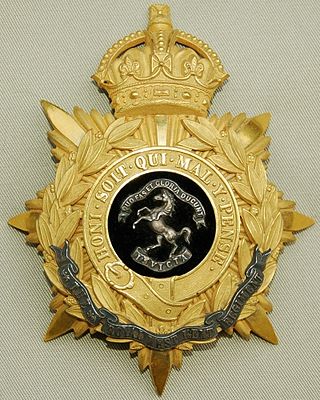12th Division may refer to:

The Indian Army during World War II, a British force also referred to as the British Indian Army, began the war, in 1939, numbering just under 200,000 men. By the end of the war, it had become the largest volunteer army in history, rising to over 2.5 million men in August 1945. Serving in divisions of infantry, armour and a fledgling airborne force, they fought on three continents in Africa, Europe and Asia.
In military terms, 15th Division or 15th Infantry Division may refer to:

The 4th Infantry Division was a regular infantry division of the British Army with a very long history, seeing active service in the Peninsular War, the Crimean War, the First World War, and during the Second World War. It was disbanded after the war and reformed in the 1950s as an armoured formation before being disbanded and reformed again and finally disbanded on 1 January 2012.

The Australian and New Zealand Army Corps (ANZAC) was originally a First World War army corps of the Mediterranean Expeditionary Force. It was formed in Egypt in December 1914, and operated during the Gallipoli campaign. General William Birdwood commanded the corps, which primarily consisted of troops from the First Australian Imperial Force and 1st New Zealand Expeditionary Force, although there were also British and Indian units attached at times throughout the campaign. The corps disbanded in 1916, following the Allied evacuation of the Gallipoli peninsula and the formation of I ANZAC Corps and II ANZAC Corps. The corps was reestablished, briefly, in the Second World War during the Battle of Greece in 1941. The term 'ANZAC' has been used since for joint Australian–New Zealand units of different sizes.

The British Commonwealth Occupation Force (BCOF) was the British Commonwealth taskforce consisting of Australian, British, Indian and New Zealand military forces in occupied Japan, from 1946 until the end of occupation in 1952.

The Queen's Own Royal West Kent Regiment was a line infantry regiment of the British Army based in the county of Kent in existence from 1881 to 1961. The regiment was created on 1 July 1881 as part of the Childers Reforms, originally as the Queen's Own (Royal West Kent Regiment), by the amalgamation of the 50th (Queen's Own) Regiment of Foot and the 97th (The Earl of Ulster's) Regiment of Foot. In January 1921, the regiment was renamed the Royal West Kent Regiment (Queen's Own) and, in April of the same year, was again renamed, this time as the Queen's Own Royal West Kent Regiment.

The 11th Armoured Division was an armoured division of the British Army which was created in March 1941 during the Second World War. The division was formed in response to the unanticipated success of the German panzer divisions. The 11th Armoured was responsible for several major victories in the Battle of Normandy from in the summer of 1944, shortly after the Normandy landings, and it participated in the Allied advance from Paris to the Rhine, the Rhine crossing in March 1945. It was disbanded in January 1946 and reformed towards the end of 1950. In 1956, it was converted into the 4th Infantry Division.

The 36th Indian Infantry Division was an infantry division of the Indian Army during the Second World War. The division was subsequently redesignated as a British Army formation, the 36th Infantry Division in September 1944. It served in India and during the Burma Campaign. After the end of the war it was disbanded and its remaining British units were transferred to the British 2nd Infantry Division.

The 2nd Parachute Brigade was an airborne forces brigade formed by the British Army during the Second World War.

The Royal Sussex Regiment was a line infantry regiment of the British Army that was in existence from 1881 to 1966. The regiment was formed in 1881 as part of the Childers Reforms by the amalgamation of the 35th Regiment of Foot and the 107th Regiment of Foot. The regiment saw service in the Second Boer War, and both World War I and World War II.

The Persia and Iraq Command was a command of the British Army established during the Second World War in September 1942 in Baghdad. Its primary role was to secure from land and air attack the oilfields and oil installations in Persia and Iraq. Its further role was to ensure the transport of supplies from Persian Gulf ports through Iraq and Persia to the Soviet Union.

13th Corps was a corps-sized formation of the British Army that fought on the Western Front during the First World War and was reformed for service during the Second World War, serving in the Mediterranean and Middle East throughout its service.

The Northumberland Hussars was a Yeomanry regiment of the British Army, transferred to the Royal Artillery for the duration of the Second World War. It was disbanded as an independent Territorial Army unit in 1967, a time when the strength of the Territorial Army was greatly reduced. The regiment's name lives on in the title of the command and support squadron of the Queen's Own Yeomanry (QOY), a Formation Reconnaissance Regiment based in Newcastle upon Tyne.
The 5th (Mhow) Division was a regular division of the British Indian Army and part of the Southern Army which was formed in 1903 after Lord Kitchener was appointed Commander-in-Chief, India between 1902 and 1909. He instituted large-scale reforms, including merging the three armies of the Presidencies into a unified force and forming higher level formations, eight army divisions, and brigading Indian and British units. Following Kitchener's reforms, the British Indian Army was "the force recruited locally and permanently based in India, together with its expatriate British officers."

The 46th Infantry Division was a British Army infantry division formed during the Second World War that fought during the Battle of France, the Tunisian Campaign, and the Italian Campaign. In March 1939, after Germany re-emerged as a significant military power and occupied Czechoslovakia, the British Army increased the number of divisions in the Territorial Army (TA) by duplicating existing units. The 46th Infantry Division was formed in October 1939, as a second-line duplicate of the 49th Infantry Division. The division's battalions were drawn largely from men living in the English North Midlands.
The 4th Infantry Division was an infantry formation of the Russian Imperial Army that existed in various formations from 1806 until the end of World War I and the Russian Revolution. When the war broke out in 1914 it was based in Łomża. In June 1917, it was designated as the 4th Infantry Shock Division upon being reformed as a shock troop unit and the following month it became known as the 4th Infantry Shock Division of Death.













